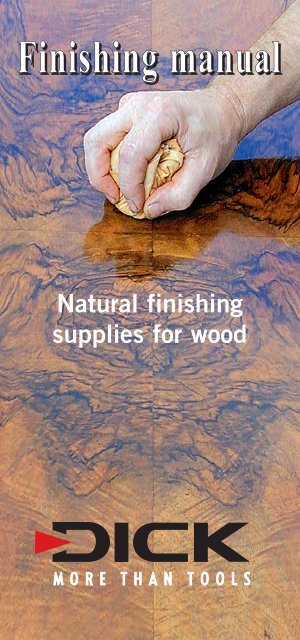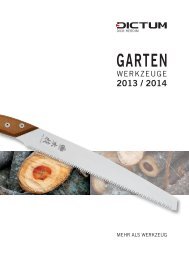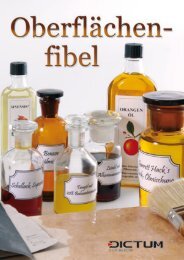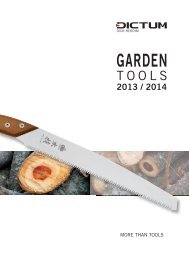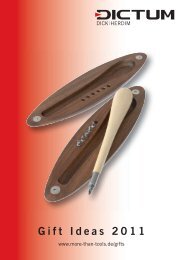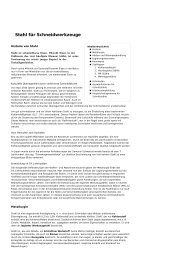Download the Natural Finishing Manual in PDF
Download the Natural Finishing Manual in PDF
Download the Natural Finishing Manual in PDF
Create successful ePaper yourself
Turn your PDF publications into a flip-book with our unique Google optimized e-Paper software.
<strong>F<strong>in</strong>ish<strong>in</strong>g</strong> manual<br />
<strong>Natural</strong> f<strong>in</strong>ish<strong>in</strong>g<br />
supplies for wood
<strong>Natural</strong> <strong>F<strong>in</strong>ish<strong>in</strong>g</strong> Supplies<br />
Wood is a beautiful material. What could be more natural<br />
to protect its beauty than us<strong>in</strong>g <strong>the</strong> f<strong>in</strong>ishes provided by<br />
nature? Therefore we will present pure natural products for<br />
natural f<strong>in</strong>ish<strong>in</strong>g <strong>in</strong> this brochure. No matter whe<strong>the</strong>r you<br />
will mix <strong>the</strong> f<strong>in</strong>ishes or use <strong>the</strong>m purely – you will always<br />
know its content.<br />
Vegetable oils<br />
Vegetable oils are proven f<strong>in</strong>ishes to protect <strong>the</strong> wooden<br />
surface. They are extracted out of vegetable raw materials,<br />
e.g. l<strong>in</strong>seed oil is extracted out of l<strong>in</strong>seed, tung oil out of<br />
<strong>the</strong> tung nut, walnut oil out of walnuts or soy bean oil out<br />
of soy beans.<br />
Advantages of oiled surfaces<br />
1. Breathable: <strong>the</strong> oiled surface rema<strong>in</strong>s breathable and<br />
keeps its warm and tactile nature.<br />
2. Harden<strong>in</strong>g of <strong>the</strong> surface: s<strong>in</strong>ce <strong>the</strong> oil takes quite<br />
long to harden, it can deeply penetrate and thus harden<br />
<strong>the</strong> surface.<br />
3. No brittleness and crack<strong>in</strong>g: The surface is <strong>in</strong>ured<br />
to deformation by extension or shr<strong>in</strong>k<strong>in</strong>g.<br />
4. Easy to repair: slight damages or erosion can be<br />
corrected with <strong>the</strong> same oil by polish<strong>in</strong>g.<br />
5. Lighten<strong>in</strong>g <strong>the</strong> gra<strong>in</strong>:<br />
Oils will emphasize <strong>the</strong><br />
gra<strong>in</strong> of <strong>the</strong> wood and<br />
emphasize its natural<br />
beauty.<br />
6. Ecological:<br />
Oiled surfaces are very<br />
environmentally friendly.<br />
Usually dry<strong>in</strong>g oils are used that harden when gett<strong>in</strong>g <strong>in</strong><br />
contact with oxygen, e.g. l<strong>in</strong>seed oil or tung oil. The dry<strong>in</strong>g<br />
is effected by <strong>the</strong> reaction of <strong>the</strong> conta<strong>in</strong>ed fatty acids<br />
with oxygen, <strong>the</strong>refore <strong>the</strong>se oils are often called fatty oils.<br />
They can be used purely or reduced. These oils are <strong>the</strong> basis<br />
for many usual varnish. Mostly pre-oxidized oils or dry<strong>in</strong>g<br />
accelerators are used to speed up <strong>the</strong> dry<strong>in</strong>g. As dilution<br />
2
and aromatic enrichment th<strong>in</strong> and volatile oils like balsam<br />
oil of turpent<strong>in</strong>e or orange oil. Used only pure <strong>the</strong>y are not<br />
suitable for <strong>the</strong> f<strong>in</strong>ish of wood. Then <strong>the</strong>re are non-harden<strong>in</strong>g<br />
vegetable oils, like Camellia oil. They can be used as<br />
polish<strong>in</strong>g oil or antirust agents for metals, <strong>the</strong>y are not very<br />
suitable for long-last<strong>in</strong>g wood preservation. Vegetable oils<br />
can be mixed <strong>in</strong> order to achieve specific characteristics.<br />
Dry<strong>in</strong>g Accelerator<br />
Dry<strong>in</strong>g accelerators, also called siccatives, are added to<br />
most of <strong>the</strong> purchasable oil mixes <strong>in</strong> order to reduce <strong>the</strong><br />
dry<strong>in</strong>g time. The catalytic effect is created by metal jo<strong>in</strong>ts<br />
(cobalt, heavy metals oxides). This way <strong>the</strong> oil is no longer<br />
environmentally friendly. Besides <strong>the</strong> penetration is reduced<br />
by shorten<strong>in</strong>g <strong>the</strong> dry<strong>in</strong>g time and thus <strong>the</strong> long-last<strong>in</strong>g<br />
protection. Therefore we recommend to not add any<br />
siccatives.<br />
Surface<br />
You can oil all natural f<strong>in</strong>ished, gr<strong>in</strong>ded or polished and dry<br />
wooden surfaces. Best suitable with a grit of 180 – 220 and<br />
a wood moisture of less than 12°. Open-pored woods like<br />
rosewood and wenge should first be treated with gra<strong>in</strong> fillers.<br />
Layer composition<br />
It is vital to first apply <strong>the</strong> soft and <strong>the</strong>n <strong>the</strong> harder part,<br />
e.g. first shellak ground <strong>the</strong>n oil and f<strong>in</strong>ally wax. If it is<br />
necessary to apply several oil layers <strong>the</strong> first application<br />
should be reduced. The follow<strong>in</strong>g layers should only be<br />
applied once <strong>the</strong> previous one has tried and <strong>the</strong> f<strong>in</strong>ish has<br />
been done.<br />
M<strong>in</strong>eral and animal oils<br />
In addition to <strong>the</strong> vegetable oils m<strong>in</strong>eral oil derivates are<br />
also used as wood preservation, e.g. paraff<strong>in</strong> oil, which are<br />
usually <strong>the</strong> basis of many hard oils. Several culture groups<br />
traditionally used animal oils, like fish oil. These oils will not<br />
be considered <strong>in</strong> this brochure.<br />
Security advice<br />
All cur<strong>in</strong>g oils can heat up dur<strong>in</strong>g polymerisation. If <strong>the</strong><br />
cloth is still wet or oil-soaked a risk of spontaneous ignition<br />
is likely! Please store <strong>in</strong> closed conta<strong>in</strong>ers or under water.<br />
3
L<strong>in</strong>seed Oil<br />
Swedish L<strong>in</strong>seed Oil Swedish L<strong>in</strong>seed Oil<br />
Ra L<strong>in</strong>olja®, raw L<strong>in</strong>olja®, Sun-bleached<br />
Derivation<br />
L<strong>in</strong>seed oil is made out of <strong>the</strong> seeds<br />
of <strong>the</strong> flax plant (L<strong>in</strong>um usitatissimum),<br />
cold- or warm-pressed or by<br />
Flax seed<br />
extraction. It is sold <strong>in</strong> different forms: pure, as stand oil<br />
(heated), preoxidized, as varnish, bleached or res<strong>in</strong>ated with<br />
dry<strong>in</strong>g accelerators. The Swedish l<strong>in</strong>seed oils we offer are<br />
extracted by a gentle cold press. They stand out due to <strong>the</strong>ir<br />
very high percentage of natural l<strong>in</strong>oleic acids, which accelerate<br />
<strong>the</strong> dry<strong>in</strong>g properties. These are pure food safe natural<br />
products without any chemical additives.<br />
Properties<br />
As cur<strong>in</strong>g oil l<strong>in</strong>seed oil has ever been <strong>the</strong> basis of most<br />
of <strong>the</strong> varnishes and wood protection oils. L<strong>in</strong>seed oil<br />
emphasises <strong>the</strong> gra<strong>in</strong>, protects aga<strong>in</strong>st moisture and dirt,<br />
is easy to use and highly environmental friendly. In <strong>the</strong> long<br />
term an <strong>in</strong>tensification and darken<strong>in</strong>g is to be expected.<br />
The surface is hardened by <strong>the</strong> bond<strong>in</strong>g of L<strong>in</strong>oxyn and it<br />
will become mechanically robust.<br />
Maple surface<br />
Left: untreated surface (cleaned with a plane). Centered: treated with Swedish<br />
L<strong>in</strong>seed Oil. Right: treated with Alkanna toned Swedish L<strong>in</strong>seed Oil<br />
Ra L<strong>in</strong>olja<br />
S<strong>in</strong>ce it takes quite long for <strong>the</strong> raw L<strong>in</strong>seed Oil to dry<br />
(1 – 4 weeks) it deeply penetrates <strong>in</strong>to <strong>the</strong> wood surface.<br />
4
Flax flower <strong>in</strong> Sweden<br />
L<strong>in</strong>olja<br />
Once <strong>the</strong> L<strong>in</strong>olja has been cold-pressed it is exposed to <strong>the</strong><br />
sun and thus bleached and preoxidized. Therefore it is very<br />
transparent and dries much quicker than raw L<strong>in</strong>seed oil.<br />
(Dry<strong>in</strong>g time accord<strong>in</strong>g to environmental conditions and<br />
surface one to several days).<br />
Use<br />
We recommend <strong>the</strong> L<strong>in</strong>seed oil surface especially for<br />
<strong>in</strong>teriors: furniture with slight and medium exposure,<br />
wooden parts with body contact (kitchen, cutt<strong>in</strong>g board,<br />
handles, toys, musical <strong>in</strong>struments) and <strong>in</strong> sensitive areas<br />
(children´s room, bedroom, sauna etc.).<br />
Any mixtures with o<strong>the</strong>r vegetable oils (with wax or ros<strong>in</strong>)<br />
is possible. But usually <strong>the</strong> L<strong>in</strong>seed oil is heated <strong>in</strong> order to<br />
improve <strong>the</strong> solubility.<br />
Bowl by Wille Sundqvist, Nordic Masur Birch,<br />
soaked with L<strong>in</strong>seed Oil and polished.<br />
Application<br />
The application of <strong>the</strong> L<strong>in</strong>seed Oil should be done across <strong>the</strong><br />
gra<strong>in</strong> us<strong>in</strong>g brushes or cloths, it should be polished along<br />
<strong>the</strong> gra<strong>in</strong>.<br />
Add-on of scented oils<br />
To create a pleasant smell 5-10% of Orange oil can be added.<br />
Deep impregnation<br />
Small objects with high exposure (e.g. handles or wooden<br />
spoons) can be deeply impregnated by completely soak<strong>in</strong>g<br />
<strong>the</strong> object for several days <strong>in</strong>to L<strong>in</strong>seed Oil.<br />
5
Example for high-quality L<strong>in</strong>seed Oil layer coat<strong>in</strong>g<br />
Polish <strong>the</strong> surface (gr<strong>in</strong>d 180 – 240), wet with water, let it<br />
dry and repolish it with a gr<strong>in</strong>d of 240 – 330. First application:<br />
heat <strong>the</strong> L<strong>in</strong>seed Oil slowly up to 55°C (if possible <strong>in</strong><br />
water bath) or th<strong>in</strong> with 20% Balsam oil of turpent<strong>in</strong>e. Let<br />
it soak <strong>in</strong> for 1 hour and wipe it off. Intermediate sand<strong>in</strong>g<br />
after dry<strong>in</strong>g (about 1 day) with 320 emery cloth. Second till<br />
fourth application without th<strong>in</strong>n<strong>in</strong>g and <strong>in</strong>termediate sand<strong>in</strong>g.<br />
After several weeks of dry<strong>in</strong>g polish with a l<strong>in</strong>t-free<br />
cotton cloth. Polish about 2 times per year with beeswax.<br />
L<strong>in</strong>seed Oil Egg Tempera<br />
Whisk<strong>in</strong>g <strong>the</strong> water-<strong>in</strong>soluble L<strong>in</strong>seed oil with egg it will be<br />
solubilised to a water-soluble tempera. This pa<strong>in</strong>t<strong>in</strong>g media,<br />
which was already famous with renaissance pa<strong>in</strong>ters, is<br />
excellently suitable to make colours (by add<strong>in</strong>g pigments),<br />
that feature age<strong>in</strong>g resistance and wipe resistance.<br />
Recipe suggestion (accord<strong>in</strong>g to Wille Sundqvist):<br />
L<strong>in</strong>seed oil/egg = 1/1 whisk, add one to two parts water, <strong>in</strong><br />
order to improve <strong>the</strong> durability add about 2 -5 % balsam oil<br />
of turpent<strong>in</strong>e & pigments accord<strong>in</strong>g to requirements.<br />
Consume shortly or store <strong>in</strong> <strong>the</strong> refrigerator.<br />
Ra L<strong>in</strong>olja® L<strong>in</strong>olja®<br />
1 liter No. 705354 1 liter No. 705275<br />
5 liter No. 705355 5 liter No. 705269<br />
6
Swedish red, iron-oxide pigment<br />
Derivation<br />
Orig<strong>in</strong>al Falun Red was a<br />
byproduct of copper m<strong>in</strong><strong>in</strong>g<br />
and consequently had a<br />
high heavy-metal content.<br />
Today, it is <strong>in</strong>creas<strong>in</strong>gly<br />
be<strong>in</strong>g replaced by an iron-oxide pigment that is nearly<br />
identical <strong>in</strong> color, free of toxic matter and has a similarly<br />
effective protective function. In a water or l<strong>in</strong>seed oil emulsion,<br />
it easily becomes a high-yield, breathable, natural<br />
color that protects wood from UV rays and pests.<br />
Use<br />
It def<strong>in</strong>es <strong>the</strong> landscape of Sweden: The warm rust color of<br />
wooden barns, houses and churches not only blends harmoniously<br />
with <strong>the</strong> green of <strong>the</strong> natural surround<strong>in</strong>gs, it is<br />
also an effective wood protector.<br />
Recipe suggestions<br />
Red protective coat for exterior walls (<strong>the</strong> oldest color of<br />
Scand<strong>in</strong>avian exterior pa<strong>in</strong>t): P<strong>in</strong>e oil + 10-20% iron-oxide<br />
pigment. Fertility approx. 3-5 qm/l.<br />
Water-based red pa<strong>in</strong>t: 10 l water, 750 g white or rye flour,<br />
3 kg iron oxide, 300 g green vitriol (iron (II) sulfate (can be<br />
obta<strong>in</strong>ed <strong>in</strong> pharmacies), 1 l l<strong>in</strong>seed oil, a bit of soft soap.<br />
Mix <strong>the</strong> flour with 2 l water until <strong>the</strong>re are no clumps.<br />
Br<strong>in</strong>g 8 l of water to boil. Stir <strong>the</strong> flour mixture <strong>in</strong>to <strong>the</strong><br />
boil<strong>in</strong>g water and cont<strong>in</strong>ue to boil for 15 m<strong>in</strong>utes, stirr<strong>in</strong>g<br />
cont<strong>in</strong>uously. Add <strong>the</strong> iron oxide and cook for a fur<strong>the</strong>r 15<br />
m<strong>in</strong>utes while stirr<strong>in</strong>g. Add <strong>the</strong> l<strong>in</strong>seed oil and soft soap (as<br />
emulsifier) and cook for a fur<strong>the</strong>r 15 m<strong>in</strong>utes while stirr<strong>in</strong>g.<br />
After it has cooled, it may be used (or th<strong>in</strong>ned).<br />
1 liter yields ca. 3-5 m²/l.<br />
1000 g No. 705344<br />
7
Lignea® - Ch<strong>in</strong>ese Tung oil<br />
Derivation<br />
Lignea is a 100% natural product obta<strong>in</strong>ed from <strong>the</strong> nutlike<br />
fruits of <strong>the</strong> Ch<strong>in</strong>ese tung tree (aleurites fordii). Due to<br />
its excellent protective qualities, tungoil has for centuries<br />
been simply known as “wood oil”.<br />
Properties<br />
Tungoil is relatively viscous and has a dist<strong>in</strong>ctive nutty<br />
odour which disappears dur<strong>in</strong>g dry<strong>in</strong>g almost completely.<br />
Tung oil is absorbed by wooden surfaces very quickly and<br />
hardens <strong>the</strong>m after it has dried, mak<strong>in</strong>g <strong>the</strong>m mechanically<br />
stronger and highly water-resistant. It provides approximately<br />
twice as much protection as l<strong>in</strong>seed oil. It deepens<br />
colours and enhances <strong>the</strong> contrast of <strong>the</strong> gra<strong>in</strong>, but <strong>the</strong><br />
wood reta<strong>in</strong>s its natural visual and tactile characteristics.<br />
The protective film is elastic, even <strong>in</strong> <strong>the</strong> long term, and, <strong>in</strong><br />
contrast to l<strong>in</strong>seed oil, darkens very little. If <strong>the</strong> f<strong>in</strong>ish becomes<br />
damaged, it can be easily retouched by rubb<strong>in</strong>g more<br />
oil over <strong>the</strong> damaged area.<br />
Use<br />
Lignea is suitable to protect wood <strong>in</strong>doors and outdoors, e.g.<br />
for furniture, garden furniture, fences, rust, timber<strong>in</strong>g, espalier,<br />
floor<strong>in</strong>g, turned pieces, musical <strong>in</strong>struments, wooden toys<br />
and wooden boats.<br />
8<br />
Tung-Nuts<br />
Hav<strong>in</strong>g oiled <strong>the</strong> surface <strong>the</strong> gra<strong>in</strong> will be very much emphasised, above all <strong>the</strong><br />
contrast between gra<strong>in</strong>-cut and cross-cut timber. The picture shows an ash<br />
table top with cones by Charles Beresford, shellac base coat and two layers of<br />
balsam oil of turpent<strong>in</strong>e mixed with 10% orange oil.
It can also be used for <strong>the</strong> protection of cloths and even brickwork<br />
(thanks to a complete coat of Tung oil <strong>the</strong> Ch<strong>in</strong>ese Wall<br />
has been so well preserved). A th<strong>in</strong> coat of Tung oil has also<br />
proven as anti-corrosion varnish for metals, e.g. low carbon<br />
steel, bronze or brazen parts. Lignea is easy to apply – even <strong>in</strong><br />
several layers – with a brush to cloth. It can be th<strong>in</strong>ned with<br />
balsam oil of turpent<strong>in</strong>e or be mixed with o<strong>the</strong>r vegetable oils<br />
accord<strong>in</strong>g to <strong>the</strong> user´s preference.<br />
Example of use<br />
Ornamental wood<br />
(Turnery, carv<strong>in</strong>g, wooden jewellery) Tung oil /Camellia oil /<br />
Orange oil = 10/1 /0,5 Good penetration, very well polishable<br />
and protection aga<strong>in</strong>st dirt.<br />
Outdoors<br />
(Wooden decks, fences, garden furniture etc)<br />
First layer: Tung oil, Balsam oil of turpent<strong>in</strong>e = 10/1, <strong>in</strong>termediate<br />
gr<strong>in</strong>d<strong>in</strong>g. Fur<strong>the</strong>r two to four layers: pure Tung oil,<br />
undiluted. Very good wea<strong>the</strong>r protection.<br />
Indoors<br />
(Flor<strong>in</strong>g, stairs, furniture etc)<br />
First layer: Tung oil, Balsam oil of<br />
turpent<strong>in</strong>e = 10/1, <strong>in</strong>termediate gr<strong>in</strong>d<strong>in</strong>g.<br />
One to three fur<strong>the</strong>r layers: Tung oil/ L<strong>in</strong>seed<br />
oil / Orange oil = 10/2/0,5 or Tung oil/<br />
Beeswax / Balsam oil of turpent<strong>in</strong>e =<br />
10/0.5/1 (first dissolve<br />
<strong>the</strong> Beeswax<br />
<strong>in</strong> Balsam oil of<br />
turpent<strong>in</strong>e) or<br />
Tung oil/Orange<br />
oil = 10/1 very<br />
f<strong>in</strong>e and odorant<br />
surfaces with<br />
very good<br />
abrasion and<br />
dirt protection.<br />
Stool from Peter Hook,<br />
treated with Tung oil<br />
mixture<br />
9
Tung oil as gra<strong>in</strong> filler<br />
Pure Tung oil can also be used as gra<strong>in</strong> filler. Apply a thick<br />
layer and let it soak <strong>in</strong> without wip<strong>in</strong>g off <strong>the</strong> excess. Let it<br />
dry until it has become viscous. Now rub <strong>in</strong> <strong>the</strong> thicken<strong>in</strong>g<br />
oil with a cloth and take wipe off <strong>the</strong> excess. Hav<strong>in</strong>g dried<br />
<strong>the</strong> procedure can be repeated up to five times depend<strong>in</strong>g<br />
on <strong>the</strong> necessary density and transparency.<br />
Dry<strong>in</strong>g time<br />
Lignea is not pre-oxidised and due to ecological reasons<br />
not mixed with chemical dry<strong>in</strong>g accelerators (siccatives).<br />
Therefore a longer dry<strong>in</strong>g time is to be expected (1/2 day up<br />
to several days). The dry<strong>in</strong>g time depends on <strong>the</strong> environmental<br />
conditions, type of wood and pre-treated surface.<br />
In case of treat<strong>in</strong>g medium density fibreboards or similar<br />
materials <strong>the</strong> dry<strong>in</strong>g time might be prolonged due to <strong>the</strong><br />
deep penetration of <strong>the</strong> oil (and miss<strong>in</strong>g contact with<br />
oxygen).<br />
�<br />
Pure Tung oil is quite viscous, <strong>the</strong> penetration behaviour<br />
can be improved by th<strong>in</strong>n<strong>in</strong>g or heat<strong>in</strong>g it.<br />
We recommend to th<strong>in</strong> <strong>the</strong> oil with Balsam oil<br />
of turpent<strong>in</strong>e (10% - 50%) when apply<strong>in</strong>g it for <strong>the</strong> first<br />
time.<br />
Do not apply <strong>the</strong> Lignea Tung oil <strong>in</strong> <strong>the</strong> blaz<strong>in</strong>g sun and wipe<br />
off any excess maximum ½ hour after application. Do not<br />
apply <strong>the</strong> Lignea Tung oil to wet wood (maximum 15 %<br />
wood moisture).<br />
The pure and liquid Lignea Tung oil has a nutty odor, which<br />
wears off after hav<strong>in</strong>g dried or if it has been mixed with<br />
Orange oil or Balsam oil of turpent<strong>in</strong>e.<br />
We do not recommend <strong>the</strong> Tung Oil for compact furniture<br />
like drawers or <strong>the</strong> <strong>in</strong>side of closet. In liquid state (dur<strong>in</strong>g treatment)<br />
Tung Oi may cause irritations<br />
or allergical reactions when gett<strong>in</strong>g<br />
<strong>in</strong> contact with <strong>the</strong> sk<strong>in</strong>. We recommend<br />
to wear protection gloves.<br />
Once it has completely dried <strong>the</strong> oil<br />
film is chemically stable and free<br />
from harmfull emissions.<br />
10<br />
1 liter bottle No. 705286<br />
5 lter bottle No. 705283
Poppy-seed oil<br />
Derivation<br />
This oil which is extracted from <strong>the</strong> seeds of <strong>the</strong> white<br />
poppy flower (Papaver somniferum), was ever s<strong>in</strong>ce <strong>the</strong><br />
most important natural b<strong>in</strong>der for high quality pa<strong>in</strong>t oils<br />
and artists colours.<br />
Properties<br />
Poppy-seed oil belongs to <strong>the</strong> dry<strong>in</strong>g oils. But dry<strong>in</strong>g times<br />
are very long (up to two weeks per application), <strong>the</strong> f<strong>in</strong>al<br />
hardness is less than that of L<strong>in</strong>seed oil. The ma<strong>in</strong> advantage<br />
compared to o<strong>the</strong>r vegetable oils is, it does not yellow.<br />
Multiple coats of poppyseed oil yield a warm, silky gloss and<br />
a surface which is pleasant to <strong>the</strong> touch. Poppyseed oil is<br />
food save and can be mixed with o<strong>the</strong>r natural oils and<br />
pa<strong>in</strong>t th<strong>in</strong>ners.<br />
Application<br />
Thanks to its high transparency poppy-seed oil is <strong>the</strong> basis<br />
for viol<strong>in</strong> varnish and o<strong>the</strong>r clear wood protection varnish.<br />
It protects aga<strong>in</strong>st moisture and dirt and<br />
tightens <strong>the</strong> wood surface due to its<br />
deep penetration. We recommend it for<br />
handcrafted items, turned objects, toys<br />
and kitchen utensils. Because of it` s<br />
good grip on surfaces it is suitable for<br />
kitchen knife and tool handles. In comb<strong>in</strong>ation<br />
with pigments it can be used<br />
to make colour oils and artists´ colours.<br />
1 li ter bottle No. 705272<br />
5 li ter bottle No. 705268<br />
Squirrel hair brush<br />
For apply<strong>in</strong>g shellac, f<strong>in</strong>e<br />
oil varnishes and water<br />
colours. Very best quality,<br />
made from <strong>the</strong> tail hairs of Siberian squirrels.<br />
Length 190 – 205 mm<br />
Head width approx. Head width approx.<br />
13 mm No. 706109 38 mm No. 706111<br />
25 mm No. 706110 50 mm No. 706112<br />
11
S<strong>in</strong>ensis® - Ch<strong>in</strong>ese Camellia Oil<br />
Derivation<br />
S<strong>in</strong>ensis is pressed out of <strong>the</strong> seed of<br />
<strong>the</strong> Ch<strong>in</strong>ese Camellia Tree (Camellia<br />
S<strong>in</strong>ensis). It is a pure natural product<br />
without any chemical additives.<br />
camellia seeds<br />
Properties<br />
Camellia Oil is a non-dry<strong>in</strong>g oil of clear to yellowish colour.<br />
It is quite th<strong>in</strong>, not volatile, food safe and odourless.<br />
Use<br />
<strong>F<strong>in</strong>ish<strong>in</strong>g</strong><br />
Apply<strong>in</strong>g it to wooden surfaces <strong>the</strong> low viscose oil will<br />
quickly absorb and improves <strong>the</strong> polishability. It is clear, will<br />
not discolour and serves to accentuate <strong>the</strong> wood’s natural<br />
beauty. It does not<br />
harden and is thus<br />
only a limited<br />
protection aga<strong>in</strong>st<br />
humidity and dirt.<br />
But it can be used to th<strong>in</strong> viscous wood oils, e.g. Tung Oil<br />
<strong>in</strong> order to improve <strong>the</strong> application and penetration.<br />
Varnish<br />
Camellia Oil can be used to oil <strong>the</strong> cloths when do<strong>in</strong>g<br />
French polish<strong>in</strong>g. When polish<strong>in</strong>g oil varnished surfaces<br />
pumice powder or triple powder is used as gr<strong>in</strong>d<strong>in</strong>g material.<br />
In this comb<strong>in</strong>ation S<strong>in</strong>ensis oil is also very suitable to<br />
clean and polish old varnished surfaces of antiques or<br />
music <strong>in</strong>struments.<br />
Corrosion protection<br />
Camellia oil is acid-free and not volatile, mak<strong>in</strong>g it <strong>the</strong><br />
ideal oil to protect tools, knives and firearms from rust. It<br />
is especially well-suited for <strong>the</strong> preservation of kitchen<br />
knives made of high carbon steel. Apply<strong>in</strong>g it very th<strong>in</strong><br />
with a cotton cloths or paper card web will be sufficient.<br />
12<br />
Knife handle by Maikal Eklund
Lubrication<br />
S<strong>in</strong>ce S<strong>in</strong>sensis does not harden and features little surface<br />
tension it is very well suited as lubricant of small jo<strong>in</strong>ts and<br />
mechanic parts, e.g. saw<strong>in</strong>g mach<strong>in</strong>es, fold<strong>in</strong>g knives, toys,<br />
fish<strong>in</strong>g reels as well as tools.<br />
Body care<br />
Camellia oil makes an excellent<br />
base for <strong>the</strong> preparation of<br />
lotions, creams and soaps. Used<br />
as massage oil it makes <strong>the</strong> sk<strong>in</strong><br />
smooth. Japanese Geishas have<br />
always used it as hair oil. The<br />
traditional Ch<strong>in</strong>ese medic<strong>in</strong>e<br />
grants it to have numerous<br />
homeopathic effect.<br />
camellia tree<br />
Add<strong>in</strong>g 5% of Orange oil will give <strong>the</strong> S<strong>in</strong>sensis oil an<br />
aromatic scent, which is very pleasant when be<strong>in</strong>g<br />
� used as body care of wood f<strong>in</strong>ish.<br />
Apply<strong>in</strong>g it to plane soles, S<strong>in</strong>esis improves <strong>the</strong> slid<strong>in</strong>g on <strong>the</strong><br />
workpiece area and <strong>the</strong> penetration behaviour of chisels <strong>in</strong>to<br />
<strong>the</strong> wood.<br />
100 ml glass bottle No. 705280<br />
250 ml glass bottle No. 705281<br />
1 liter storage bottle No. 705282<br />
Polish<strong>in</strong>g and clean<strong>in</strong>g fabric<br />
F<strong>in</strong>ely woven tubular fabric made of tough, l<strong>in</strong>t-free,<br />
terry-cloth-like cotton. Ideal for<br />
polish<strong>in</strong>g wood and varnish<br />
surfaces, for clean<strong>in</strong>g as well<br />
as for packag<strong>in</strong>g fragile items.<br />
20 metres per roll No. 810008<br />
13
Orange Oil<br />
Derivation<br />
Orange oil is extracted as pure oil<br />
without any chemicals additives from<br />
<strong>the</strong> peel of <strong>the</strong> sweet orange (Citrus<br />
S<strong>in</strong>sensis).<br />
Properties<br />
Due to its <strong>in</strong>tensive and refresh<strong>in</strong>g scent it is used <strong>in</strong> aroma<strong>the</strong>rapy,<br />
as additive <strong>in</strong> scented oils, bath<strong>in</strong>g oils, creams and<br />
soaps. Due to its strongly fat-dissolv<strong>in</strong>g properties it is a very<br />
effective and ecological clean<strong>in</strong>g and car<strong>in</strong>g product for<br />
wooden and plastic surfaces. It is also suited as dissolver and<br />
th<strong>in</strong>ner for oil pa<strong>in</strong>ts and as pa<strong>in</strong>t brush cleanser. It can be<br />
mixed with any vegetable oils, e.g. Camellia Oil, L<strong>in</strong>seed Oil<br />
or Tung Oil, to which it lends a pleasant and vitalis<strong>in</strong>g scent.<br />
Recommended use<br />
We recommend to add 5-20% of Orange Oil to Tung Oil if<br />
used <strong>in</strong>side to ease <strong>the</strong> strong scent. Besides <strong>the</strong> Tung oil<br />
becomes th<strong>in</strong>ner and thus can be better applied and penetrates<br />
deeper <strong>in</strong>to <strong>the</strong> wood. In comb<strong>in</strong>ation with carnauba<br />
wax or beeswax it can make a variety of agents for clean<strong>in</strong>g<br />
and car<strong>in</strong>g for wooden surfaces and lea<strong>the</strong>r.<br />
Notice<br />
Orange oil may cause light-coloured wood or untreated<br />
wood surfaces to discolour. The high citrus acid content<br />
found <strong>in</strong> pure orange oil may irritate <strong>the</strong> sk<strong>in</strong> and mucous<br />
membranes.<br />
14<br />
250 ml glass bottle<br />
No. 705277<br />
1 liter storage bottle<br />
No. 705278
Balsam Oil of Turpent<strong>in</strong>e<br />
Derivation<br />
The Balsam Oil of Turpent<strong>in</strong>e is obta<strong>in</strong>ed<br />
by double-distill<strong>in</strong>g <strong>the</strong> res<strong>in</strong> of <strong>the</strong><br />
maritime p<strong>in</strong>e tree. Be<strong>in</strong>g one of <strong>the</strong><br />
most valuable solvents on a natural<br />
basis it has always been used <strong>in</strong> pa<strong>in</strong>-<br />
P<strong>in</strong>e cone<br />
t<strong>in</strong>g and handcrafted application. Do<br />
not mistake <strong>the</strong> Balsam Oil of Turpent<strong>in</strong>e with <strong>the</strong><br />
so-called “White Spirit”, which is a m<strong>in</strong>eral oil product.<br />
Properties<br />
The th<strong>in</strong> oil is colourless and has a fresh essential scent.<br />
It residue-free volatilizes from <strong>the</strong> respective pa<strong>in</strong>t<strong>in</strong>g when<br />
dry<strong>in</strong>g. Normally <strong>the</strong> dry<strong>in</strong>g time will be <strong>in</strong>creased when<br />
add<strong>in</strong>g <strong>the</strong> Balsam Oil of Turpent<strong>in</strong>e, as <strong>the</strong> oil penetrates<br />
deeper <strong>in</strong>to <strong>the</strong> wood.<br />
Use<br />
We recommend to use <strong>the</strong> Balsam Oil of Turpent<strong>in</strong>e to th<strong>in</strong><br />
vegetable oils (Camelia Oil, Tung Oil, L<strong>in</strong>seed Oil, P<strong>in</strong>e Tar Oil<br />
etc) and oil pa<strong>in</strong>t, varnish, pa<strong>in</strong>t base as well as to dissolve<br />
ros<strong>in</strong> and wax and to produce lacquer and polish. It can also<br />
be used as cleaner for brushes or cleanser.<br />
Notice<br />
Please observe <strong>the</strong> normal safety precautions for <strong>the</strong><br />
use of volatile solvents conta<strong>in</strong><strong>in</strong>g hydrocarbons.<br />
Extensive applications <strong>in</strong>side are only to be made when<br />
adequate air<strong>in</strong>g and dry<strong>in</strong>g-out time is provided. Allergic<br />
reactions are possible when gett<strong>in</strong>g <strong>in</strong> contact with <strong>the</strong><br />
mucosa. Balsam Oil of Turpent<strong>in</strong>e<br />
should be stored lightproof. It is<br />
perishable when gett<strong>in</strong>g <strong>in</strong> contact<br />
with oxygen.<br />
1 liter storage bottle<br />
No. 705288<br />
15
Worth read<strong>in</strong>g<br />
Oberflächenbehandlung von Holz No. 713739<br />
Classical techniques and formulas,<br />
by Sam Allen. Treat<strong>in</strong>g wood with oils,<br />
res<strong>in</strong>s and waxes makes wood easier<br />
to care for and accentuates its natural<br />
beauty. Sam Allen has compiled all<br />
<strong>the</strong> traditional methods and recipes<br />
for treat<strong>in</strong>g wooden surfaces.<br />
In addition to a very thorough<br />
description of French polish<strong>in</strong>g with<br />
shellac, Mr. Allen also addresses <strong>the</strong><br />
use of varnishes, oils, waxes, abrasives, sta<strong>in</strong>s and case<strong>in</strong><br />
based pa<strong>in</strong>t. 128 pp., 165 colour illustrations, hardcover,<br />
210 x 255 mm, <strong>in</strong> German.<br />
Behandlung von Holzoberflächen No. 713360<br />
By Derrick Crump. Noth<strong>in</strong>g is more<br />
disappo<strong>in</strong>t<strong>in</strong>g than a complex surface<br />
treatment which does not have <strong>the</strong><br />
desired result. This book helps you<br />
avoid mistakes with a thorough <strong>in</strong>troduction<br />
to <strong>the</strong> chemistry of sta<strong>in</strong>s,<br />
pa<strong>in</strong>ts, oils and waxes and <strong>the</strong>ir correct<br />
use, as well as surface preparation.<br />
176 pages, over 300 illustrations,<br />
hardcover, 197 x 272 mm, <strong>in</strong> German.<br />
Naturfarben Handbuch No. 713253<br />
The authors of this book have dug<br />
deeply <strong>in</strong>to nature’s bag of tricks to<br />
come up with this collection of <strong>the</strong><br />
best natural pa<strong>in</strong>ts and glazes for<br />
f<strong>in</strong>ish<strong>in</strong>g wood. The properties of<br />
various natural pigments, b<strong>in</strong>d<strong>in</strong>g<br />
agents and solvents are provided<br />
along with numerous recipes and<br />
f<strong>in</strong>ish<strong>in</strong>g techniques. 190 pp., numerous<br />
colour illustrations, hardcover,<br />
190 x 290 mm, <strong>in</strong> German.<br />
16
Vom Färben des Holzes No. 713757<br />
By Hans Michaelsen and Ralf<br />
Buchholz. Almost 2000 historical<br />
recipes suitable for sta<strong>in</strong><strong>in</strong>g and<br />
color<strong>in</strong>g wood, ivory, bone, horn<br />
and straw. To facilitate a better<br />
understand<strong>in</strong>g of <strong>the</strong>se antique<br />
recipes, several of <strong>the</strong> techniques<br />
<strong>the</strong>y reference are additionally described<br />
and detail descriptions of <strong>the</strong><br />
properties of various <strong>in</strong>gredients are<br />
also provided. 220 x 229 mm, 800 pages,<br />
hardcover, 387 color and 231 b/w illustrations, <strong>in</strong> German.<br />
Handbuch Möbel aufarbeiten No. 713860<br />
By George Buchanan. Buchanan<br />
guides readers through restoration<br />
cases of vary<strong>in</strong>g difficulty step-bystep:<br />
from easy to restore tables, to<br />
chairs, chests of drawers or almost<br />
destroyed pieces. A well-illustrated<br />
reference work for beg<strong>in</strong>ners and<br />
professionals. 300 pages, approximately<br />
1000 draw<strong>in</strong>gs and some<br />
colour panels, hardback, 170 x 240 mm,<br />
<strong>in</strong> German.<br />
Intarsien No. 713721<br />
Techniques and design step-by-step,<br />
by Jack Metcalfe and John Apps.<br />
This technical book promises an<br />
easy <strong>in</strong>troduction to <strong>the</strong> art of<br />
<strong>in</strong>lays. In addition to present<strong>in</strong>g a<br />
wide range of materials, tools and<br />
techniques, <strong>the</strong> path to completion<br />
is expla<strong>in</strong>ed <strong>in</strong> twelve courses. The<br />
many objects, with <strong>in</strong>structions on<br />
how to make <strong>the</strong>m yourself, give<br />
you ideas to deepen your newly acquired skills.<br />
176 pages, 386 colour illustrations, softcover,<br />
190 x 248 mm, <strong>in</strong> German.<br />
17
Swedish P<strong>in</strong>e Tar Oil<br />
Derivation<br />
Tar oil, extracted from <strong>the</strong> tar-rich rootstock of p<strong>in</strong>e trees<br />
by charr<strong>in</strong>g and careful distillation, is one of <strong>the</strong> oldest<br />
wood-protect<strong>in</strong>g agents.<br />
Properties<br />
The thick oil has a strongly smoky aroma, dries very slowly<br />
and deeply penetrates <strong>in</strong>to <strong>the</strong> raw wood. It provides a<br />
long-term protection aga<strong>in</strong>st decomposition, fungal or<br />
<strong>in</strong>sect attack. Depend<strong>in</strong>g on <strong>the</strong> distillation <strong>the</strong> oil has a<br />
light brown to dark brown colour, which gives <strong>the</strong> wood a<br />
beautiful, antique pat<strong>in</strong>a. The oil can be mixed with L<strong>in</strong>seed<br />
Oil and dilutable with Balsam Oil of Turpent<strong>in</strong>e. Add<strong>in</strong>g<br />
iron-oxide pigments an orig<strong>in</strong>al Swedish red pa<strong>in</strong>t can be<br />
achieved (see page 7).<br />
Application<br />
In Scand<strong>in</strong>avia it has been used to coat houses, sh<strong>in</strong>gles,<br />
fences, equipment, sleighs and boats for hundreds of years.<br />
P<strong>in</strong>e-tar oil is ideal for protect<strong>in</strong>g <strong>the</strong> handles of axes and<br />
o<strong>the</strong>r equipment, s<strong>in</strong>ce it allows <strong>the</strong> wood to brea<strong>the</strong> and<br />
improves <strong>the</strong> grip.<br />
Furutjära® p<strong>in</strong>e tar<br />
A very rich and thick oil of dark colour. Given this oil's<br />
strong, smoky aroma, we recommend it only be used<br />
outdoors.<br />
1 liter No. 705347<br />
5 liter canister No. 705349<br />
18
Dalbränd Tjära® f<strong>in</strong>e p<strong>in</strong>e tar<br />
This high-quality wood tar is somewhat lighter and th<strong>in</strong>ner<br />
than Furutjära p<strong>in</strong>e tar and emphasises <strong>the</strong> gra<strong>in</strong> more.<br />
1 liter No. 705351<br />
5 liter canister No. 705352<br />
�<br />
To reduce <strong>the</strong> smoky scent we recommend to add<br />
<strong>the</strong> Orange Oil and s<strong>in</strong>ge<strong>in</strong>g after dry<strong>in</strong>g when<br />
apply<strong>in</strong>g it <strong>in</strong>side.<br />
untreated treated with treated with<br />
Furutjära® Dalbränd Tjära®<br />
Wood sh<strong>in</strong>gles on<br />
a Swedish church<br />
preserved with tar oil.<br />
19
Ros<strong>in</strong> and Wax<br />
Shellac<br />
Derivation<br />
The base of shellac is<br />
an exudate of secretion<br />
from East Indian scale<br />
<strong>in</strong>sects (Coccus lacca),<br />
which is processed to a<br />
th<strong>in</strong> ros<strong>in</strong>. The qualities<br />
differ accord<strong>in</strong>g to <strong>the</strong><br />
purity, wax content and<br />
color<strong>in</strong>g. In order to<br />
apply <strong>the</strong> shellac it<br />
has to be dissolved <strong>in</strong><br />
alcohol.<br />
Properties<br />
Shellac is notable for its hardness, transparency and bond<strong>in</strong>g<br />
strength. Its excellent <strong>in</strong>sulative properties make it <strong>the</strong><br />
substance of choice for use <strong>in</strong> traditional gild<strong>in</strong>g (as a primer<br />
coat and fixative). French polish<strong>in</strong>g is an <strong>in</strong>comparable<br />
way of br<strong>in</strong>g<strong>in</strong>g out <strong>the</strong> beauty of <strong>the</strong> wood. It creates a<br />
mechanically wear-resistant, physiologically compatible<br />
f<strong>in</strong>ish that does not become brittle and is of constant<br />
colour. Defective torn parts can be easily repaired by polish<strong>in</strong>g.<br />
Shellac surfaces can be corroded by chemical cleansers<br />
or alcohol, but are quite <strong>in</strong>sensitive to water and moisture.<br />
Application<br />
We recommend to produce a liquid solution as follows:<br />
1/1 till 1/2 with alcohol (pure ethanol, at least 96 %).<br />
The full dissolution of <strong>the</strong> wax can take several days,<br />
depend<strong>in</strong>g on <strong>the</strong> temperature. Stir <strong>the</strong> solution well at<br />
least 4 times a day.<br />
The most important additive of French polish<strong>in</strong>g is <strong>the</strong><br />
cloth rubb<strong>in</strong>g pad. It consists of a wool centre, wrapped <strong>in</strong><br />
a l<strong>in</strong>t-free cotton or l<strong>in</strong>en cloth. The polish<strong>in</strong>g and clean<strong>in</strong>g<br />
fabric (see page 13) has proven as very useful (it can also<br />
be used without <strong>the</strong> wool fill<strong>in</strong>g). For each polish<strong>in</strong>g a<br />
separate cloth is necessary.<br />
20<br />
Hand-polished shellac table by Robert Zerzawy<br />
(Ebony, amboyna-burl <strong>in</strong>laid)
The composition of <strong>the</strong> shellac surface consists of <strong>the</strong><br />
follow<strong>in</strong>g steps:<br />
Basic polish<strong>in</strong>g: porefiller with shellac and pumice<br />
powder.<br />
Cover polish<strong>in</strong>g: <strong>the</strong> layer structure is to be achieved <strong>in</strong><br />
several rounds with <strong>in</strong>termediate dry<strong>in</strong>g until a compact<br />
surface has been achieved (approx. 2 – 6 layers, depend<strong>in</strong>g<br />
on <strong>the</strong> wood and pretreatment).<br />
Polish<strong>in</strong>g: mix <strong>the</strong> sh<strong>in</strong>e polish<strong>in</strong>g with a light solution,<br />
possibly with benzo<strong>in</strong> ros<strong>in</strong> or benzo<strong>in</strong> pa<strong>in</strong>t. The exact<br />
procedure would be too detailed for this brochure. It can<br />
be best thought <strong>in</strong> one of our workshops (please see our<br />
brochure). French polish<strong>in</strong>g is also very well suited to be<br />
used as base coat for oily or wax surfaces. It hardens<br />
<strong>the</strong> wooden surface and prevents it from volatilis<strong>in</strong>g. The<br />
shellac solution cannot be mixed with o<strong>the</strong>r oils. Therefore<br />
<strong>the</strong> shellac base has to dry well before <strong>the</strong> oil is applied.<br />
Astra shellac - Bleached, highly<br />
transparent shellac, for clear<br />
polishes.<br />
250 g No. 810030<br />
1000 g No. 810031<br />
Komet shellac - Orange-coloured<br />
shellac for polishes that display<br />
a slight t<strong>in</strong>ge.<br />
250 g No. 810034<br />
1000 g No. 810035<br />
Superior shellac - Reddish shellac<br />
for polish<strong>in</strong>g with marked t<strong>in</strong>ge<br />
and for accentuat<strong>in</strong>g <strong>the</strong> gra<strong>in</strong>.<br />
250 g No. 810037<br />
1000 g No. 810038<br />
DVD: Introduction to<br />
French Polish<strong>in</strong>g No. 713753<br />
Peter Zehmisch, a master furniture<br />
restorer, describes <strong>the</strong> French polish<strong>in</strong>g<br />
process <strong>in</strong> detail, rely<strong>in</strong>g on his<br />
many decades of experience work<strong>in</strong>g<br />
<strong>the</strong> field. All of <strong>the</strong> <strong>in</strong>dividual steps -<br />
surface preparation, pore-fill<strong>in</strong>g, padd<strong>in</strong>g and f<strong>in</strong>al<br />
polish<strong>in</strong>g - are discussed <strong>in</strong> detail. Approx. 21 m<strong>in</strong>utes,<br />
<strong>in</strong> English.<br />
21
Urushi (Au<strong>the</strong>ntic Japanese Varnish)<br />
Derivation<br />
It is made from <strong>the</strong> natural res<strong>in</strong> of <strong>the</strong> Asian tea tree<br />
(rhus vernicifera) and has been used <strong>in</strong> Japan to protect<br />
and lend a beautiful gloss to furniture, bowls, boxes,<br />
handles and jewelry for over 6,000 years.<br />
Properties<br />
Once fully hardened, Urushi varnishes are resistant to<br />
water, heat, alcohol, acids, bases and solvents. In addition,<br />
Urushi varnishes are not susceptible to wear and are 100 %<br />
natural. Any number of coats can be applied, without <strong>the</strong><br />
risks of crack<strong>in</strong>g or granulation. Urushi can be applied to<br />
almost any surface, <strong>in</strong>clud<strong>in</strong>g wood, clay, fabric, paper,<br />
metal or plastic and can also be burned on.<br />
Application<br />
Japanese Urushi embodies <strong>the</strong> art of varnish<strong>in</strong>g <strong>in</strong> its<br />
highest form. It can be used for varnish<strong>in</strong>g newly made<br />
objects as well as for restor<strong>in</strong>g antiques and can also be<br />
used for sett<strong>in</strong>g <strong>in</strong>lays. Colored Urushi can ei<strong>the</strong>r be used<br />
directly out of <strong>the</strong> tube or made by mix<strong>in</strong>g pigments <strong>in</strong>to<br />
transparent Urushi.<br />
Note: It requires special varnish<strong>in</strong>g techniques and must be dried at a constant<br />
humidity. For a s<strong>in</strong>gle varnish coat, primer, pore filler (Tonoko), Urushi<br />
and Tsunoko polish are required. Balsam turpent<strong>in</strong>e can be used to th<strong>in</strong><br />
Urushi. Comes with <strong>in</strong>structions for use, which can also be looked at <strong>in</strong> our<br />
webshop www.more-than-tools.de at <strong>the</strong> correspond<strong>in</strong>g article. Urushi can<br />
cause sk<strong>in</strong> and mucosa irriations when be<strong>in</strong>g liquid (not when hav<strong>in</strong>g<br />
dried).<br />
Urushi (100g-tube)<br />
Primer transparent (Ki) No. 716240<br />
Varnish transparent (Jo-Shuai) No. 716241<br />
Varnish red medium No. 716242<br />
Varnish black (Jo-Kuro) No. 716243<br />
22
Handicraft courses<br />
Handicraft at its best – <strong>the</strong> more than 200 courses are held<br />
by highly qualified tutors. K<strong>in</strong>dly ask for <strong>the</strong> complete free<br />
workshop brochure at www.more-than-tools.de<br />
Surface f<strong>in</strong>ish<br />
(2 days, approx. 16 hours)<br />
Content: f<strong>in</strong>ish<strong>in</strong>g of wooden<br />
surfaces with traditional<br />
materials like wax, oil and ros<strong>in</strong>.<br />
Choos<strong>in</strong>g <strong>the</strong> right f<strong>in</strong>ish is<br />
often very difficult – even for<br />
professionals. We will demonstrate<br />
which f<strong>in</strong>ish is most suitable<br />
for <strong>the</strong> various k<strong>in</strong>ds of wood and how to use <strong>the</strong>m.<br />
In German.<br />
Acoustics and lacquer<strong>in</strong>g for<br />
mak<strong>in</strong>g a viol<strong>in</strong> (4 days,<br />
approx. 32 hours)<br />
Content: <strong>in</strong>troduction to<br />
lacquer<strong>in</strong>g, <strong>the</strong> necessary raw<br />
materials to prepare <strong>the</strong> lacquer,<br />
preparation of lacquer,<br />
spirit lacquer, oil lacquer, presta<strong>in</strong><strong>in</strong>g,<br />
sta<strong>in</strong><strong>in</strong>g. Application<br />
of <strong>the</strong> basic lacquer and <strong>the</strong> coloured licquer, polish<strong>in</strong>g of<br />
<strong>the</strong> lacquer. Various methods of analyz<strong>in</strong>g and affect<strong>in</strong>g <strong>the</strong><br />
frequencies of <strong>the</strong> wood: pick<strong>in</strong>g, Fuhr method with glass<br />
tubes, Hutch<strong>in</strong>son method with frequency regenerator etc..<br />
In German.<br />
French polish<strong>in</strong>g<br />
(3 days, approx. 24 hours)<br />
Content: material science,<br />
preparation of <strong>the</strong> lacquer and<br />
surface, mak<strong>in</strong>g of <strong>the</strong> cotton<br />
cloth, polish<strong>in</strong>g of a board (60<br />
x 80cm) several times (basic<br />
polish<strong>in</strong>g), cover polish<strong>in</strong>g and<br />
special technology. Dur<strong>in</strong>g <strong>the</strong><br />
dry<strong>in</strong>g time you may discuss difficult cases, sources of error<br />
and questions regard<strong>in</strong>g restor<strong>in</strong>g (you may also br<strong>in</strong>g your<br />
own furniture with you). In German.<br />
23
Propolis 100 g No. 810012<br />
Derivation<br />
Propolis is a ros<strong>in</strong> which is secreted by <strong>the</strong> gland of honey<br />
bees <strong>in</strong> order to glue combs.<br />
Properties<br />
The res<strong>in</strong>ous cement collected by bees to stop up crevasses<br />
<strong>in</strong> <strong>the</strong>ir hives has been used by humank<strong>in</strong>d s<strong>in</strong>ce ancient<br />
times both as a natural medic<strong>in</strong>e (for its anti-<strong>in</strong>flammatory,<br />
antibacterial and antiviral effect) and as an <strong>in</strong>gredient <strong>in</strong><br />
f<strong>in</strong>e wood varnishes and oils. None o<strong>the</strong>r than Stradivarius<br />
used propolis to improve <strong>the</strong> flexibility, durability and visual<br />
appearance of his varnishes. Propolis also has a very pleasant<br />
aroma, attributable to <strong>the</strong> p<strong>in</strong>e and poplar res<strong>in</strong> it conta<strong>in</strong>s,<br />
which makes it an excellent way of enrich<strong>in</strong>g any<br />
homemade f<strong>in</strong>ish.<br />
Application<br />
In addition, its natural antibacterial and antifungal effect<br />
makes propolis, <strong>in</strong> comb<strong>in</strong>ation with a food safe oil (e.g. our<br />
Swedish l<strong>in</strong>seed oil) <strong>the</strong> perfect choice for treat<strong>in</strong>g wooden<br />
household objects which come <strong>in</strong> frequent contact with <strong>the</strong><br />
sk<strong>in</strong>, such as kitchen utensils, cutt<strong>in</strong>g boards, sauna and<br />
bathroom furniture and children’s toys.<br />
Pure Propolis Varnish<br />
Mix 300 - 400 g of propolis with 1 liter of high percentage<br />
ethyl alcohol (spirit alcohol 98% or stronger). Let <strong>the</strong> mixture<br />
steep for 8 - 14 days, shake several times a day. Pour<br />
<strong>the</strong> dissolved solution (without dregs) off and filter it (e.g.<br />
us<strong>in</strong>g a doubled nylon stock<strong>in</strong>g). The result<strong>in</strong>g pure propolis<br />
varnish can be applied directly to wooden surfaces. It<br />
hardens relatively slowly and yields a yellowish brown color.<br />
T<strong>in</strong>cture<br />
This pure propolis-alcohol solution, once mixed with 70%<br />
water, has proven to be an effective “t<strong>in</strong>cture” for medic<strong>in</strong>al<br />
use (to treat wounds and as a dis<strong>in</strong>fectant, pa<strong>in</strong> reliever<br />
and immune system booster).<br />
24
Marple-surface<br />
Left: untreated (f<strong>in</strong>ished by plane). Right: varnished with Propolis-L<strong>in</strong>seed Oil<br />
varnish<br />
Propolis-L<strong>in</strong>seed Oil Varnish<br />
Ratio by weight of l<strong>in</strong>seed oil / beeswax / propolis = 8 / 2,5 / 4.<br />
This recipe yields a high quality, pleasant-smell<strong>in</strong>g and<br />
ecologically friendly varnish for wooden objects which come<br />
<strong>in</strong> frequent contact with sk<strong>in</strong>, e.g. children’s toys, bathroom<br />
and sauna furniture, kitchen utensils, wooden spoons, etc.<br />
We recommend us<strong>in</strong>g a l<strong>in</strong>seed oil which is free of chemicals,<br />
such as our L<strong>in</strong>olja oil (No. 705275). To make <strong>the</strong> varnish,<br />
first warm <strong>the</strong> l<strong>in</strong>seed oil to ca. 60° - 70° C and dissolve<br />
<strong>the</strong> propolis <strong>in</strong> <strong>the</strong> oil. Next, filter <strong>the</strong> solution and mix <strong>the</strong><br />
beeswax <strong>in</strong>to <strong>the</strong> warm solution. To improve <strong>the</strong> varnish’s<br />
resistance to water, 10 - 50% Ch<strong>in</strong>ese tung oil (Lignea, No.<br />
705286) may be used. The hardness of <strong>the</strong> varnish can also<br />
be <strong>in</strong>creased by replac<strong>in</strong>g some of <strong>the</strong> beeswax with <strong>the</strong><br />
harder Carnauba wax (No. 810009).<br />
Russian Varnish<br />
Ratio by weight of l<strong>in</strong>seed oil / beeswax / propolis = 4 / 1 / 2.<br />
A variation of <strong>the</strong> varnish described above which displays a<br />
higher degree of hardness, primarily used for restor<strong>in</strong>g<br />
antiques or objects subject to heavy wear. Directions as<br />
above.<br />
Harden<strong>in</strong>g<br />
Addition of res<strong>in</strong>s such as mastic, sandarac or shellac will<br />
<strong>in</strong>crease <strong>the</strong> hardness of <strong>the</strong> varnish coat and make apply<strong>in</strong>g<br />
<strong>the</strong> varnish easier.<br />
De-Wax<strong>in</strong>g<br />
The wax dissolved <strong>in</strong> <strong>the</strong> propolis-alcohol solution can be<br />
removed if a f<strong>in</strong>ish with a higher degree of hardness is<br />
desired. Simply cool <strong>the</strong> solution until <strong>the</strong> wax solidifies<br />
at <strong>the</strong> surface are remove it from <strong>the</strong> solution.<br />
Harden<strong>in</strong>g<br />
Addition of res<strong>in</strong>s such as mastic, sandarac or shellac will<br />
<strong>in</strong>crease <strong>the</strong> hardness of <strong>the</strong> varnish coat and make apply<strong>in</strong>g<br />
<strong>the</strong> varnish easier.<br />
25
Beeswax<br />
The secretions of <strong>the</strong> glands<br />
found on <strong>the</strong> abdomen of <strong>the</strong><br />
bee, known commonly as<br />
beeswax, have been used s<strong>in</strong>ce<br />
ancient times for glu<strong>in</strong>g, polish<strong>in</strong>g and preserv<strong>in</strong>g wood.<br />
Research has shown that <strong>the</strong> planks which made up <strong>the</strong><br />
hulls of Punic warships were treated with pure beeswax<br />
almost 2000 years ago to protect <strong>the</strong>m from <strong>the</strong> corrosive<br />
effects of saltwater. When slightly heated (max. 70° C) and<br />
<strong>in</strong> its pure form, beeswax can be used to penetrate and<br />
treat many types of wooden surfaces. Beeswax can be<br />
mixed with oil, alcohol or turpent<strong>in</strong>e to produce a variety of<br />
polish<strong>in</strong>g and clean<strong>in</strong>g pastes and liquids. A well-proven<br />
f<strong>in</strong>ish consists of a primer coat of l<strong>in</strong>seed oil and s<strong>in</strong>gle or<br />
multiple coats of a 1 / 3 mixture of l<strong>in</strong>seed oil, turpent<strong>in</strong>e<br />
and beeswax. Surfaces treated <strong>in</strong> this manner have a beautiful,<br />
sat<strong>in</strong>y appearance, are relatively resistant to wear and<br />
can easily be retouched and ref<strong>in</strong>ished. Apply <strong>the</strong> wax solution<br />
<strong>in</strong> a th<strong>in</strong> coat and polish immediately, across <strong>the</strong> gra<strong>in</strong>.<br />
500 g No. 810006 1000 g No. 810007<br />
Paraff<strong>in</strong> wax<br />
Extracted from m<strong>in</strong>eral oil,<br />
paraff<strong>in</strong> wax is colourless, solvent-free,<br />
and water-repell<strong>in</strong>g.<br />
It is used for seal<strong>in</strong>g end gra<strong>in</strong>,<br />
<strong>in</strong> wood turn<strong>in</strong>g, for mix<strong>in</strong>g<br />
with beeswax, as a preservative<br />
for wood and metal, and for lubricat<strong>in</strong>g mov<strong>in</strong>g parts<br />
(e.g. plane soles, thread box).<br />
1000 g No. 810016<br />
Carnauba wax<br />
The leaves of <strong>the</strong> carnauba<br />
palm native to Brazil secrete<br />
a greyish-yellowish protective<br />
wax known for its hardness<br />
and excellent physiological properties. This carnauba wax is<br />
often used <strong>in</strong> cosmetic products and can be used to add<br />
hardness to beeswax polishes, improv<strong>in</strong>g <strong>the</strong>ir resistance to<br />
wear and gloss<strong>in</strong>ess. Carnauba wax is also well-suited for<br />
lubricat<strong>in</strong>g mov<strong>in</strong>g wooden parts and protect<strong>in</strong>g metal<br />
26
parts from corrosion (similar to beeswax). The wax offered<br />
here is unbleached and has a melt<strong>in</strong>g po<strong>in</strong>t of approximately<br />
90° C.<br />
A recommended wax polish<strong>in</strong>g paste:<br />
carnauba wax / beeswax / turpent<strong>in</strong>e: 1 / 2 / 2.<br />
500 g No. 810009 1000 g No. 810010<br />
Yew vessel made by Lüder Baier, waxed and polished.<br />
Kirjes® natural oil wax<br />
The wax of <strong>the</strong> bearberry (arctostaphylos<br />
uva ursi) makes <strong>the</strong> organic<br />
Swedish f<strong>in</strong>ish<strong>in</strong>g wax from<br />
Kirjes® a high-quality, organic<br />
wood protector. After sand<strong>in</strong>g,<br />
apply (preferably warm) to <strong>the</strong> wood<br />
surface, rub it <strong>in</strong> with a scrub brush<br />
and polish it with a cloth. It emphasizes<br />
<strong>the</strong> wood's natural beauty and protects it from dirt and<br />
moisture. Dry<strong>in</strong>g time is 2-4 days, and with<strong>in</strong> 2 weeks it<br />
hardens completely. O<strong>the</strong>r <strong>in</strong>gredients <strong>in</strong>clude beeswax and<br />
Swedish l<strong>in</strong>seed oil. It is free of chemicals and solvents.<br />
300 ml No. 705356<br />
27
-HolzBalsam<br />
Through and through natural<br />
for a silky gloss: Wax for<br />
reserv<strong>in</strong>g wood. Conta<strong>in</strong>s a<br />
high percentage of all-natural<br />
bee wax. HolzBalsam conta<strong>in</strong>s<br />
pure natural <strong>in</strong>gredients which<br />
preserve <strong>the</strong> wood. It is free of chemical substances,<br />
m<strong>in</strong>eral oil derivatives and dry<strong>in</strong>g activators. The ideal<br />
natural preserver for toys, kitchen equipment, turned<br />
wooden objects, wooden furniture, wooden floors, carved<br />
items and all handicraft objects. Valuable substances out<br />
of nature underl<strong>in</strong>e <strong>the</strong> beauty of a wooden surface with<br />
a silky smooth touch. The pleasant smell<strong>in</strong>g palm made of<br />
<strong>in</strong>gredients such as bee wax, carnauba wax, l<strong>in</strong>seed oil,<br />
tung oil and orange oil not only preserves normal wooden<br />
surfaces. It is easily spread on cork, smooth lea<strong>the</strong>r and<br />
metal for protection aga<strong>in</strong>st moisture.<br />
300 g No. 705350<br />
<strong>Natural</strong> dyes<br />
Alkanna root<br />
Derivation<br />
The alkanet root has long<br />
been used to produce red to<br />
reddish-violet alkann<strong>in</strong> dyes.<br />
The granulate offered here is obta<strong>in</strong>ed from <strong>the</strong> lower bark<br />
and root of a borage-like plant (alkanna t<strong>in</strong>ktura) native to<br />
Europe.<br />
Properties<br />
The dy<strong>in</strong>g agent present <strong>in</strong> alkanet root dissolves well <strong>in</strong> oil<br />
or alcohol and bonds well to organic materials, such as silk,<br />
cotton, lea<strong>the</strong>r, wood, sk<strong>in</strong> and hair. For this reason, it is<br />
particularly suited for colour<strong>in</strong>g wood oils and oil varnishes.<br />
Use<br />
The dy<strong>in</strong>g agent is go<strong>in</strong>g to be extracted by prepar<strong>in</strong>g a<br />
dissolution of <strong>the</strong> chips <strong>in</strong> ethyl alcohol (10g – 20g per<br />
100g alcohol), constantly stirr<strong>in</strong>g and f<strong>in</strong>ally filtrat<strong>in</strong>g. This<br />
concentrated dissolution can be added to <strong>the</strong> oil as needed.<br />
Ano<strong>the</strong>r method is <strong>the</strong> direct boil<strong>in</strong>g of <strong>the</strong> root granule <strong>in</strong><br />
l<strong>in</strong>seed oil. Put <strong>the</strong> chips <strong>in</strong>to a l<strong>in</strong>en bag and <strong>the</strong>n <strong>in</strong>to <strong>the</strong><br />
l<strong>in</strong>seed oil, max. heated up to 80°C. The <strong>in</strong>tensity of <strong>the</strong><br />
28
dy<strong>in</strong>g depends on <strong>the</strong> duration, temperature and stirr<strong>in</strong>g.<br />
The extracted coloured oil accentuates <strong>the</strong> wood´s natural<br />
beauty of all bright wood and prevents it from becom<strong>in</strong>g<br />
yellowish, which is a typical side effect of l<strong>in</strong>seed oil<br />
(formula accord<strong>in</strong>g to Mr councillor of commerce Hartl,<br />
conservator <strong>in</strong> Laxenburg, Vienna).<br />
100 g No. 810024<br />
Dragon´s blood<br />
Dragon's blood res<strong>in</strong> is<br />
obta<strong>in</strong>ed from <strong>the</strong> fruit of<br />
<strong>the</strong> Asian Daemonorops draco<br />
tree. Dissolvable <strong>in</strong> spirits or<br />
water, it delivers a strik<strong>in</strong>g blood-red sta<strong>in</strong> that can be used<br />
to color viol<strong>in</strong> varnishes, oil varnish or watercolors, as some<br />
examples. It can also be used <strong>in</strong> its pure form.<br />
50 g No. 810021<br />
Benzo<strong>in</strong><br />
Derivation<br />
The pure benzo<strong>in</strong> tears<br />
('almonds') offered here<br />
are harvested from Styrax<br />
trees <strong>in</strong> Siam. Incisions made <strong>in</strong> <strong>the</strong> tree's bark cause sap to<br />
exude, which hardens upon exposure to air.<br />
Properties<br />
Benzo<strong>in</strong> is a mid-strength fragrant res<strong>in</strong>. Due to its pleasant,<br />
vanilla-like aroma, it is a favoured <strong>in</strong>gredient <strong>in</strong> perfumes<br />
(Chanel No. 5), aromatic oils, o<strong>in</strong>tments and <strong>in</strong>cense.<br />
Due to its anti-<strong>in</strong>flammatory and antibacterial effect it is<br />
also used <strong>in</strong> naturopathy.<br />
Use<br />
To produce <strong>the</strong> lacquer a lotion is made by dissolv<strong>in</strong>g <strong>the</strong><br />
benzo<strong>in</strong> <strong>in</strong> ethyl alcohol (40g benzo<strong>in</strong> per 100g alcohol).<br />
This lotion is go<strong>in</strong>g to be added after filtration to vegetable<br />
oils. It improves <strong>the</strong> brushability and gives <strong>the</strong> oil a pleasant<br />
scent. When worked <strong>in</strong>to a varnish, benzo<strong>in</strong> creates a glossy<br />
f<strong>in</strong>ish for shellac surfaces or high-quality oil-varnished<br />
surfaces.<br />
100 g No. 810023<br />
29
Additive<br />
Soda<br />
For harden<strong>in</strong>g lea<strong>the</strong>r and<br />
o<strong>the</strong>r purposes, such as form<strong>in</strong>g<br />
bone plates or wood<br />
veneers. The alkal<strong>in</strong>e properties<br />
of soda (natrium carbonate)<br />
also render it useful for remov<strong>in</strong>g greasy residues,<br />
clean<strong>in</strong>g and bleach<strong>in</strong>g, and it is used <strong>in</strong> <strong>the</strong> manufacture<br />
(maceration) of colours and sta<strong>in</strong>s.<br />
500 g No. 810022<br />
Polish<br />
Pumice Powder<br />
F<strong>in</strong>e, white powder for<br />
smooth<strong>in</strong>g <strong>the</strong> layers of<br />
a f<strong>in</strong>ish, e.g. for French<br />
polish<strong>in</strong>g or as a pore filler<br />
(pumice becomes transparent<br />
when mixed with shellac). Made of pure siliceous rocks.<br />
Used with water or paraff<strong>in</strong> oil.<br />
250 g No. 810050<br />
Equipment<br />
French Flat Oil Brush<br />
Hand-made <strong>in</strong> a traditional brushmaker's shop <strong>in</strong> France for<br />
high absorption capacity, shape stability and even flow. The<br />
hand-sorted Chungk<strong>in</strong>g bristles with uncut, naturally split<br />
ends ensure a high capillary effect and form a dense brush<br />
head which allows a controlled flow. Slightly dome-shaped<br />
head for even application without overlapp<strong>in</strong>g. Nickel-plated<br />
ferrules, sta<strong>in</strong>ed beech handle. Length approx. 240 mm,<br />
head width 50 mm<br />
No. 706181<br />
30
<strong>Natural</strong> <strong>F<strong>in</strong>ish<strong>in</strong>g</strong> Supplies Starter Kit, 11-piece set<br />
Basic set with great price advantage consist<strong>in</strong>g of natural<br />
oils, waxes and res<strong>in</strong>s for mix<strong>in</strong>g your own f<strong>in</strong>ishes. An<br />
attached brochure guides through <strong>the</strong> process. Delivered<br />
with a French flat oil brush for easy application.<br />
Contents:<br />
• L<strong>in</strong>olja, Schwedish l<strong>in</strong>seed oil (705275) 1 Liter<br />
• Lignea, Ch<strong>in</strong>ese tung oil (705286) 1 Liter<br />
• Turpent<strong>in</strong>e oil (705288) 1 Liter<br />
• Pure orange oil (705277) 250 ml<br />
• S<strong>in</strong>ensis, camellia oil (705280) 100 ml<br />
• Flat oil brush (706181) width 50 mm<br />
• Pure bee wax (810006) granulate, 500 g<br />
• Carnauba wax (810009) 500 g<br />
• Benzo<strong>in</strong> (810023) 100 g<br />
• Alkanet root (810024) 100 g<br />
• Komet shellac (810034) 250 g<br />
No. 705299<br />
DICK GmbH · Donaustr. 51 · 94526 Metten · Germany<br />
Tel: 0991-9109-902 · Fax: 0991-9109-802<br />
www.more-than-tools.de · <strong>in</strong>fo@more-than-tools.de<br />
All f<strong>in</strong>ished described <strong>in</strong> this brochure can be bought directly from us<br />
(please ask for our free catalogue or have a look at our webshop).<br />
Mak<strong>in</strong>g varnishes and f<strong>in</strong>ish<strong>in</strong>g wood are sensitive endeavours. We can not<br />
guarantee <strong>the</strong> quality of <strong>the</strong> results. We <strong>the</strong>refore recommend that you test<br />
your varnishes prior to use to establish <strong>the</strong> color, mixability and dry<strong>in</strong>g times.<br />
The content of this brochure is subject to copyright.<br />
The general terms and conditions of our catalogue shall apply.


